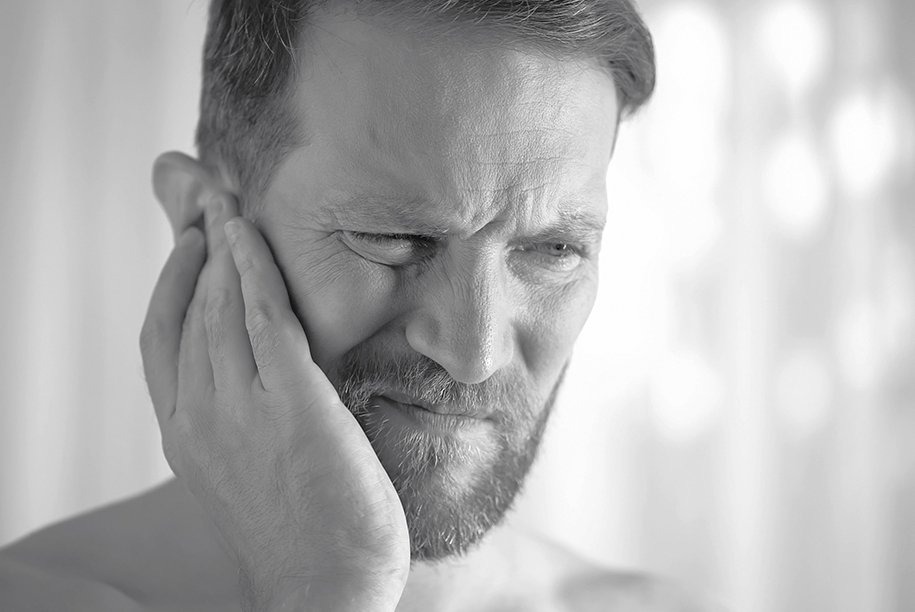atm: temporomandibular dysfunction and orofacial pain
bruxism
Bruxism is the unconscious habit of grinding the teeth at night or during the day. It is often linked to situations that require great concentration, worries, stress, anxiety, etc. In some cases bruxism is due to the fact that the upper and lower teeth are not correctly aligned and there is malocclusion. Orthodontics may be one of the solutions that a specialist dentist can recommend.
Sometimes it is due to a sleep disorder. Alcohol and caffeine consumption can aggravate this condition, so we always recommend moderation in consumption.
The consequence of bruxism is the deterioration of the functions of the chewing apparatus, especially the joint that connects the jaw to the skull bone (temporomandibular joint or TMJ). Except when chewing or swallowing, our teeth should not come into contact with each other. If this happens frequently, we subject the entire chewing apparatus to overexertion, which gradually deteriorates it. The muscles of the face, neck and all those surrounding the jaws become contracted, the jaw joint wears out, the teeth are subjected to excessive forces that are alien to their function, the gums suffer from poor blood circulation and, consequently, the whole system becomes unbalanced.
Some of the main symptoms associated with bruxism are as follows:
– Noises when opening and closing the mouth
– Pain in the jaw or widening of the face due to enlargement of the muscles
– Increased sensitivity of the teeth and gums
– Wearing away of tooth enamel Dental malocclusion
– Headache and pain in the neck and trapezius muscles
– Discomfort or discomfort in the mouth area when waking up in the morning
– Noises during the night when brushing teeth
– Broken teeth or molars, or caps or fillings falling out
– Frequent tongue biting
– Mobility in the teeth
– Earache or tinnitus (noises inside the ear)
– Snoring or hoarseness
The key to reducing the effects of these neurophysiological disorders is early diagnosis. The evolution will depend on the time of establishment of the habit, dental wear and other associated symptoms. In order to obtain an adequate diagnosis and treatment, the odontologist specialising in TMJ must carry out a complete study of the patient to be treated and in many cases it is essential to collaborate with other professionals, such as the otorhinolaryngologist, the physiotherapist, the rheumatologist or the psychologist.
The most commonly used treatment for bruxism are occlusal splints or bite splints. These appliances are made of a transparent plastic material, which, depending on each case, is placed at the level of the upper or lower arch. It is essential to carry out a complete study prior to making the splint in order to obtain the diagnosis and recommended treatment for each case. At the same time, it is often important to make some changes in diet, exercises, physiotherapy, relaxation techniques and, in certain cases, the help of psychotherapy or pharmacological treatment is necessary.
temporomandibular dysfunction
The temporomandibular joint or TMJ is the joint that allows the jaw to move. Temporomandibular dysfunction is a disorder of the structures that make up the TMJ.
There are multiple factors that can contribute to temporomandibular dysfunction, such as genetic predisposition, dental malocclusions, bruxism, postural habits, sleep disorders, among others. The causes of these dysfunctions are diverse, but they are always related to the components of the masticatory system: the muscles, the teeth and the temporomandibular joint.
The best prevention for temporomandibular dysfunction is the control of the factors that cause it. The most appropriate treatments to be carried out should be indicated by the dentist specialised in TMJ after a precise study, with the corresponding diagnosis. Some of these treatments may be: orthodontic treatments in cases of dental malocclusion, unloading plates for bruxism, modifying postural habits, intraoral appliances to treat sleep disorders, etc.
orofacial pain
Orofacial pain is the result of a painful impulse, caused by injuries to the mouth and face, which is sent to the brain via a common pathway: the trigeminal nerve.
Orofacial neuropathic pain occurs as a result of damage or disruption to the nervous system due to trauma, metabolic disorders, nutritional deficiencies, cancer, arthritis, infections, stroke or brain injury, multiple sclerosis, tumours or other causes. Symptoms of orofacial neuropathic pain are usually described as shooting, burning or electric shock-like pain.
Some of the most frequent symptoms are:
– Pain generated by something that does not normally cause pain
– Pain that persists after eliminating the cause of the pain
– abnormal and unpleasant sensations described as tingling and needle pricks
Symptoms may change over time and may be different in two patients with the same disease. The dentist specialising in orofacial pain, after a study and diagnosis, will indicate the most appropriate treatment for each patient. The main treatment is pharmacological, reserving other more aggressive treatments, such as neurosurgery, for cases in which pharmacological treatment does not achieve satisfactory results.

